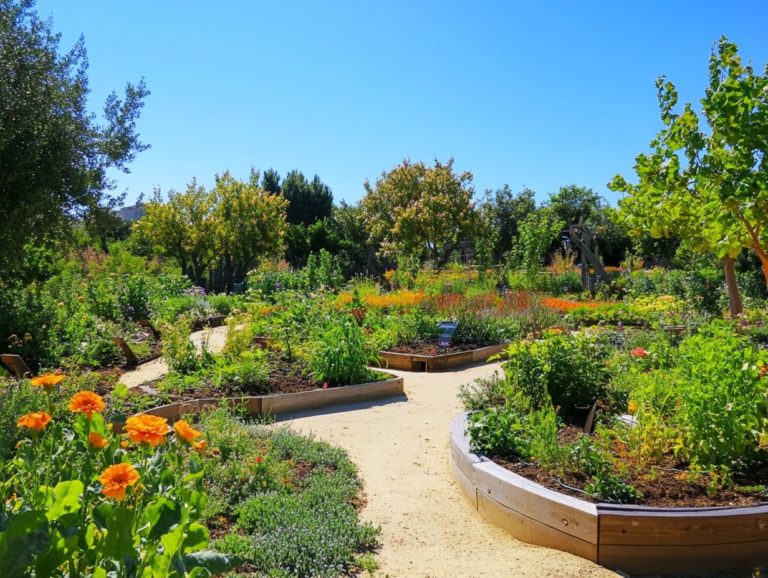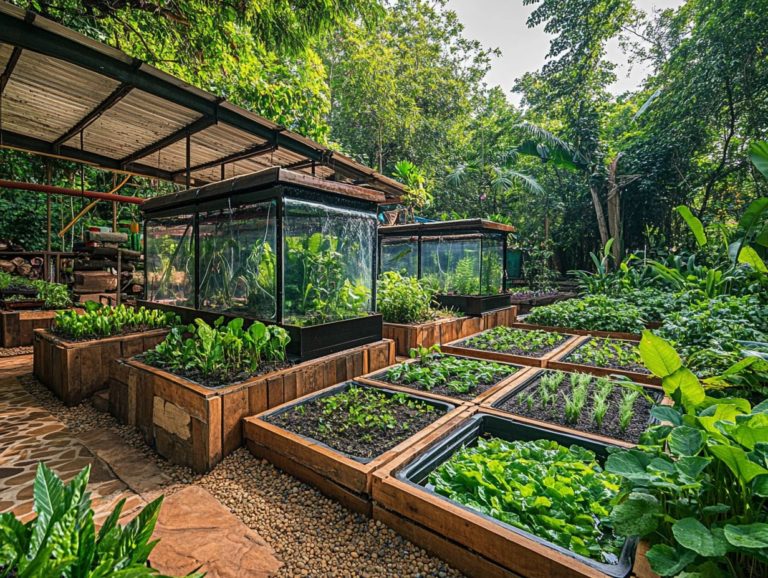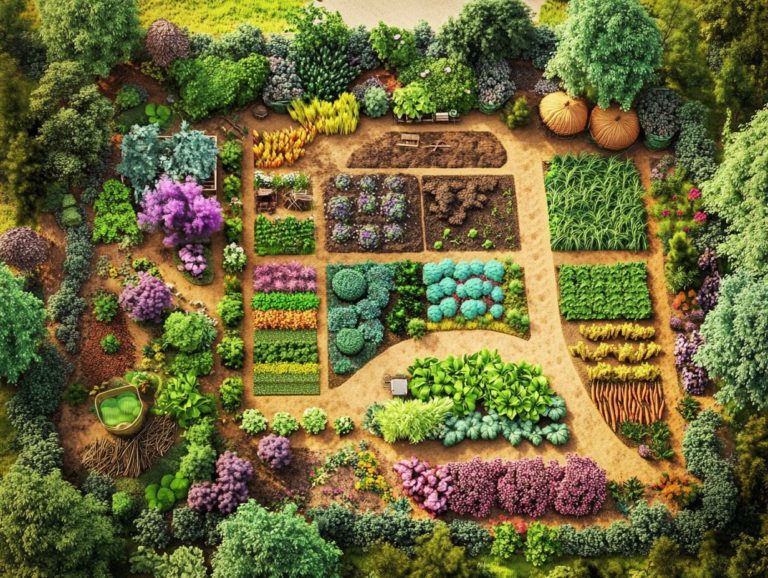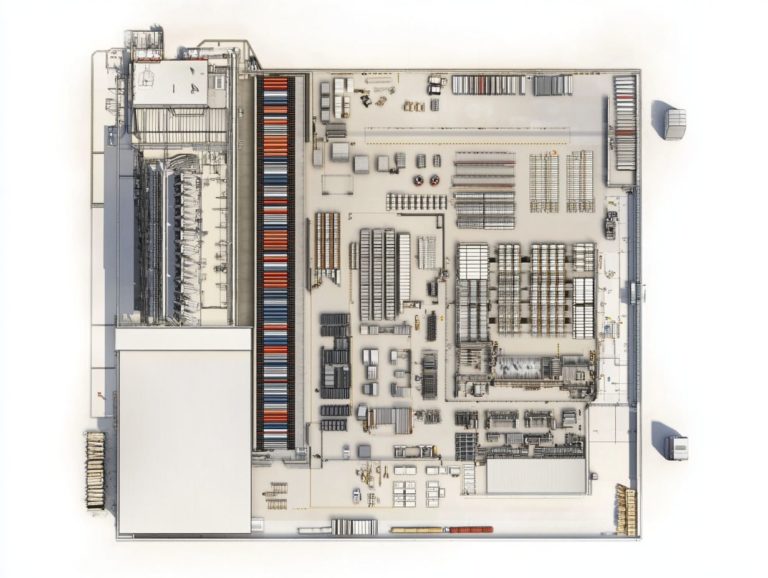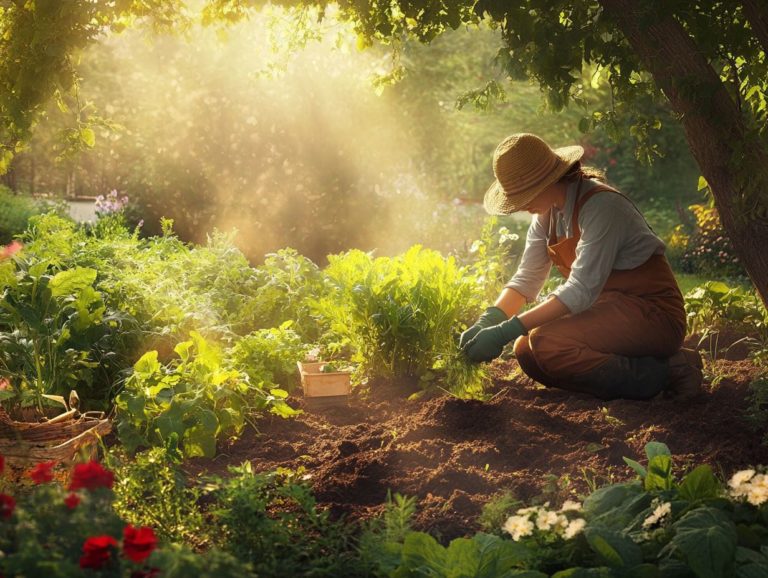Permaculture Design: Importance of Observation
Permaculture design is a comprehensive way to build sustainable ecosystems. It is a method of sustainable farming that focuses on mimicking natural ecosystems.
At the core of this practice is the art of observation. Grasping the nuances of your environment, along with its rhythms and interactions, is essential for crafting effective systems that flourish.
This article delves into the critical role observation plays in permaculture. It highlights the key elements to concentrate on and offers practical methods for implementation. It also addresses the advantages of a sharp observational mindset, along with the challenges that may arise, providing valuable insights to enhance your permaculture journey.
Whether you re just starting out or have years of experience under your belt, you ll find resources here to elevate your practice to new heights.
Contents
- Key Takeaways:
- The Importance of Observation in Permaculture Design
- Applying Observation in Permaculture Design
- Benefits of Using Observation in Permaculture Design
- Challenges and Limitations of Observation in Permaculture Design
- Frequently Asked Questions
- What is permaculture design and why is it important to observe?
- How does observation help in creating a successful permaculture design?
- Can anyone practice permaculture design or is it only for experts?
- Why is it important to observe the microclimate of a site in permaculture design?
- How can observation of natural patterns benefit permaculture design?
- Is observation an ongoing process in permaculture design?
Key Takeaways:

- Observation is crucial for a deeper understanding of natural systems and their patterns.
- Key elements to observe include weather patterns, soil health, and plant and animal interactions, which inform sustainable design decisions.
- Incorporating observation into the design process makes permaculture systems more sustainable, efficient, and resilient, overcoming common challenges.
What is Permaculture Design?
Permaculture design invites you to embrace a comprehensive method to create sustainable habitats by integrating natural patterns and ecological principles into your landscape and garden design. This transformative system seeks to enhance biodiversity, improve soil health, and cultivate a balanced ecosystem that supports human interactions while championing sustainable practices.
Originating in the 1970s through the visionary work of pioneers like Bill Mollison and David Holmgren, permaculture emphasizes designing agricultural systems that closely mimic natural ecosystems. By prioritizing perennial plants, companion planting, and efficient water conservation, you can establish resilient landscapes that flourish across various environments, whether in bustling urban settings or tranquil rural farms.
Key principles to consider include observing natural patterns, fostering community engagement, and utilizing local resources all while striving for a regenerative approach. This method boosts food production and improves ecological diversity while reducing reliance on non-renewable resources, positioning it as a vital practice in your pursuit of sustainable living.
The Importance of Observation in Permaculture Design
Observation stands as a cornerstone of permaculture design, giving you the power to gather crucial insights about your environment. These insights are essential for effective site design and achieving natural balance, as highlighted in permaculture design: the significance of feedback.
By engaging in both passive and active observations, you can discern natural patterns, comprehend resource flows, and assess existing landscape features. These elements guide your permaculture practices, ensuring a harmonious relationship with the ecosystem.
Why Observation is Crucial
Observation is crucial in permaculture because it provides essential insights about climate dynamics, wildlife interactions, and seasonal patterns that significantly influence your garden design and overall ecological health.
By meticulously observing the subtle nuances of local microclimates, you can identify areas that bask in optimal sunlight versus those that linger in shade. This knowledge guides you in selecting the right plant species while fostering enhanced biodiversity, creating more resilient ecosystems.
Recognizing the seasonal patterns of sun and shade gives you the power to strategically position structures or plants. This optimizes energy use while minimizing waste. Such thoughtful considerations ultimately cultivate a balanced environment, where the interplay among climate, wildlife, and plant life seamlessly contributes to a sustainable garden design.
Key Elements to Observe

Key elements to observe in permaculture design include landscape features, soil composition, water dynamics, and resource flows. These aspects are crucial for creating a sustainable habitat and ensuring ecological balance.
By understanding the contours of your landscape, you can significantly influence water catchment and retention. These factors are essential for maintaining healthy soil. The soil composition its texture, nutrients, and microbiology directly impacts plant growth and biodiversity.
Water dynamics encompass not just the movement and availability of water but also the interplay between various ecosystems. Areas like riparian zones and wetlands support a rich diversity of flora and fauna.
Recognizing the importance of the movement of resources, like compost, plants, and energy, encourages a regenerative approach. This approach enhances overall resilience within your ecological framework.
Applying Observation in Permaculture Design
In permaculture design, applying observation means employing a range of methods and techniques. From sensory observation to deep listening, this approach allows you to gather valuable data that informs innovative design solutions and highlights the importance of diversity while fostering ecological balance.
Methods and Techniques
The methods and techniques of observation in permaculture can be elegantly categorized into passive and active observations. Both are vital for effective data collection and a deeper understanding of nature’s wisdom.
Passive observations invite you to quietly immerse yourself in a site over time. This allows you to discern patterns, seasonal shifts, and interactions among various elements within the ecosystem. This approach reveals insights into microclimates, soil conditions, and wildlife behavior without any interference.
Active observations demand your direct involvement. They often feature experiments or interventions designed to measure outcomes in a controlled setting. Together, these methods create a complementary dynamic: passive observations provide a broad context, while active ones deliver specific data points.
Grasping these techniques is essential for anyone engaged in permaculture. They not only guide the design process but also promote sustainable practices that resonate with ecological principles.
Benefits of Using Observation in Permaculture Design
Observing nature opens up a world of incredible benefits for your permaculture design! Get ready to boost your sustainability and efficiency like never before. You’ll foster a resilient system that adapts gracefully to environmental changes and nurtures biodiversity.
Enhancing Sustainability and Efficiency

Enhancing sustainability and efficiency through observation gives you the power to optimize resource management. Align your design goals with the natural patterns of your environment.
By closely monitoring soil health, water cycles, and plant interactions, you can identify the most effective strategies for fostering biodiversity and maximizing yields. For example, a community garden in Portland showcased how observing microclimates allowed gardeners to select plant varieties that flourished in specific zones. This significantly cut down on irrigation needs.
A farm in Australia adopted a rotational grazing system based on their observations of pasture health. This led to improved soil fertility and reduced erosion. These examples illustrate that thoughtful observation not only yields greater harvests but also deepens your understanding of ecological relationships. Ultimately, this supports more resilient agricultural systems.
Creating a More Resilient System
Creating a more resilient system in permaculture requires you to foster biodiversity and promote ecological balance. This is achieved through careful observation and a deep understanding of how humans interact with the environment.
By acknowledging the intricate relationships between various species plants, animals, and microorganisms you can design systems that not only withstand environmental stressors but also thrive amid them. Implementing strategies like polycultures (growing different plants together in a single garden) and companion planting enhances these networks, allowing different species to support one another through shared nutrients and pest resistance.
Regularly monitoring soil health, water retention, and local fauna will empower you to make informed adjustments, maintaining harmony within the ecosystem.
Ultimately, this complete way of thinking encourages a rich tapestry of interactions that contribute to the longevity and productivity of your permaculture system.
Challenges and Limitations of Observation in Permaculture Design
The challenges and limitations of observation in permaculture design can really change the game for your data collection. This necessitates a patient intake evaluation on your end, allowing for a thorough understanding and analysis of your environment.
Embrace this approach to enhance your ability to navigate complexities and make informed decisions in your permaculture practices.
Overcoming Common Obstacles
Overcoming common obstacles in observation demands innovative solutions and a steadfast commitment to continuous environmental observation. This can profoundly enhance your permaculture design outcomes. Leverage technology to streamline your observation process and gain critical insights into your site’s unique conditions.
You may often face challenges such as limited access to resources, fluctuating environmental conditions, and the necessity for extensive knowledge about local ecosystems. Understanding soil composition and recognizing wildlife interactions are essential. For example, grasping the complexities of soil health or familiarizing yourself with local flora and fauna and their seasonal patterns might seem overwhelming. Yet, it is vital for making informed decisions.
To address these challenges, consider forming collaborative networks with fellow permaculture enthusiasts. Focus on community meal events to share experiences and knowledge. This approach allows for valuable knowledge sharing and resource pooling.
Additionally, use apps that help track weather patterns, assess water dynamics, or monitor soil moisture levels. These tools can yield deeper insights into the dynamics of your landscape, including natural patterns and landscape features.
Frequently Asked Questions

Understanding permaculture principles can greatly enhance your site design.
What is permaculture design and why is it important to observe?
Permaculture design is a system of principles and practices that aim to create sustainable and self-sufficient human habitats. Observation is a key component of this method, as it allows for a thorough understanding of the environment and its natural patterns, including seasonal patterns of sun. This enables more effective and efficient design decisions.
How does observation help in creating a successful permaculture design?
Observation allows for a deeper understanding of the natural environment, including climate, soil, water, and wildlife. This understanding is crucial in creating a permaculture design that emphasizes soil management that works with, rather than against, these natural systems. It also helps to identify potential challenges and opportunities for the design, such as assessing resource flows and integration opportunities within the ecosystem.
Can anyone practice permaculture design or is it only for experts?
Anyone can practice permaculture design, regardless of expertise. It improves with active and passive observations of existing plants.
Observation is a skill everyone can develop. With practice and patience, you can learn to recognize ecological balance and apply permaculture principles.
Why is it important to observe the microclimate of a site in permaculture design?
A microclimate is the weather conditions in a small area. This includes factors like temperature, sunlight, and wind.
Observing microclimates is crucial in permaculture design. It helps select and place plants and structures that will thrive in specific environments.
How can observation of natural patterns benefit permaculture design?
Natural patterns include systems like the water cycle and plant growth. By observing these patterns, you can create sustainable and resilient designs.
Mimicking natural processes helps integrate them into your design, leading to a better ecological balance.
Is observation an ongoing process in permaculture design?
Yes, observation is continuous in permaculture design. Ongoing data collection is vital to adapting your design to changing environments, as detailed in understanding the permaculture design process.
This process fosters a deeper connection with nature and inspires commitment to sustainable practices.


